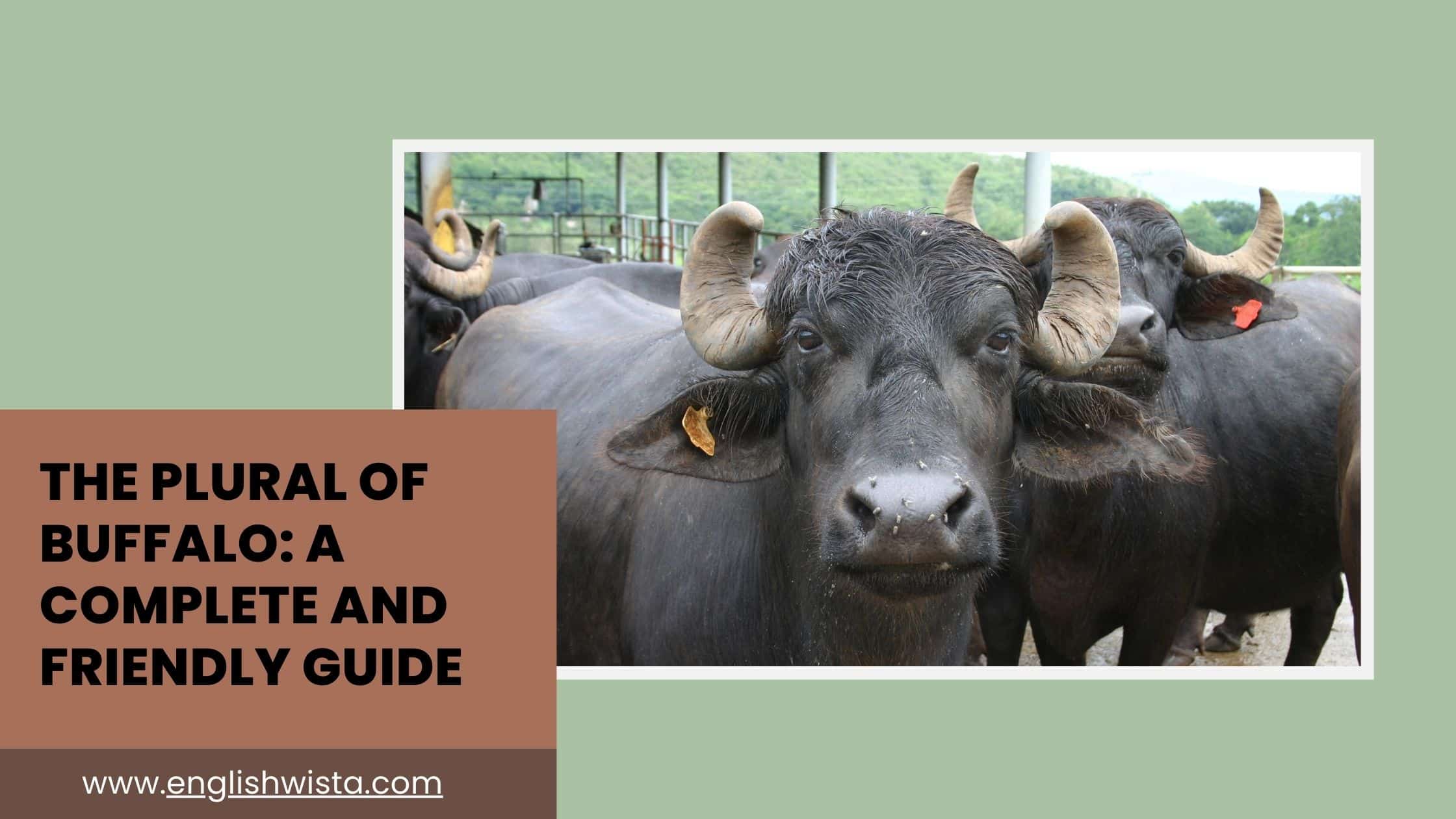Have you ever stopped in the middle of writing or speaking and asked yourself, “Wait… what’s the plural of buffalo?” You’re definitely not alone. The word buffalo is one of those English words that can make people pause. It looks simple, but when it comes to making it plural, things get a little tricky.
In this article, we’re going to dive deep into the plural of buffalo in a way that’s clear, fun, and easy to follow. Don’t worry you don’t need to be a grammar expert. We’ll go step by step, with examples, fun facts, and even a few surprising details that might make you smile. By the end, you’ll know exactly how to use buffalo in both its singular and plural forms with confidence.
Let’s get started!
What Does Buffalo Mean?
Before we figure out its plural, let’s make sure we know what buffalo means.
The word buffalo usually refers to a large animal with horns, similar to a cow, but stronger and wilder. There are different types of buffalo in the world, such as the African buffalo, the water buffalo found in Asia, and the bison in North America (which people often call “buffalo” even though that’s not their exact scientific name).
So, when we say buffalo, we’re talking about these powerful, heavy animals that often move in herds.
Definition in simple words:
- Buffalo (noun): A big, horned animal similar to a cow, living in different parts of the world.
Now that we’ve got the meaning clear, let’s move on to the big question.
What Is the Plural of Buffalo?
Here’s the answer you’ve been waiting for: the plural of buffalo can actually be buffalo or buffaloes.
Yes, that’s right there are two correct forms!
- Buffalo (no change)
- Buffaloes (with an “-es” ending)
Both are accepted in English, and both are used by native speakers.
Why Are There Two Plurals?
You might be wondering, “Why does buffalo have two plural forms when most words only have one?” Great question.
English is a language that has borrowed many words from different places Latin, Greek, Italian, French, and many more. Because of this, some words follow regular plural rules (like adding “-s” or “-es”), while others keep their original form without changing at all.
- Buffalo comes from Italian and Spanish roots (the word búfalo). In some cases, borrowed words don’t change in the plural. That’s why buffalo can stay the same.
- At the same time, English likes to use “-es” for words ending in “o.” For example: potato → potatoes, tomato → tomatoes. Following that pattern, buffalo → buffaloes is also correct.
So both options survived in English, and both are still correct today.
Which Plural Should You Use?
Here’s where things get interesting. While both plurals are correct, one is used more often depending on the context.
- Buffalo (unchanged): More common in American English. If you’re talking about herds of buffalo in North America, you’ll often see “buffalo” used as both singular and plural.
- Buffaloes (with -es): More common in British English and in formal writing. You might also see it in textbooks or scientific contexts.
In short:
- Americans tend to say “a herd of buffalo.”
- British speakers often say “a herd of buffaloes.”
Neither is wrong. It’s more about style and personal preference.
Is Buffalo Singular or Plural?
Sometimes, people get confused when they see sentences like, “The buffalo are grazing.” They think, “Wait, isn’t that singular?”
Here’s the trick: buffalo can be both singular and plural, depending on how you use it.
- Singular: “That buffalo is very strong.”
- Plural: “Those buffalo are moving across the field.”
If you add “-es” (buffaloes), then it’s clearly plural, which removes the confusion.
So, both “buffalo” and “buffaloes” can be plural, but “buffalo” can also be singular. The sentence and the verb usually tell you which one it is.
Example Sentences with Buffalo (Plural)
Let’s make this really clear with examples.
- A herd of buffalo is crossing the river.
- Many buffalo live in the grasslands of Africa.
- The buffalo are grazing peacefully in the field.
- Hunters used to chase buffalo across the plains.
- We saw dozens of buffalo during our trip to the national park.
Now let’s look at sentences with buffaloes.
- The zoo recently brought in three buffaloes.
- Buffaloes are strong animals that can weigh more than a ton.
- Farmers in Asia use buffaloes to help plow their fields.
- Water buffaloes are very common in countries like India and Thailand.
- The children were amazed to see buffaloes up close for the first time.
As you can see, both work perfectly fine.
Comparing with Other Similar Words
It might help to compare buffalo with other words that end in “o.”
- Potato → Potatoes
- Tomato → Tomatoes
- Hero → Heroes
But notice how some words ending in “o” don’t change:
- Piano → Pianos
- Photo → Photos
- Zero → Zero or Zeros (and sometimes zeroes)
So buffalo is part of this “mixed group.” Sometimes it takes “-es,” and sometimes it doesn’t.
Fun Facts About the Word Buffalo
Let’s add some fun to the learning!
- Collective noun: Did you know a group of buffalo is called a herd? So you can say “a herd of buffalo” or “a herd of buffaloes.”
- Longest grammatical sentence: There’s a famous sentence in English that only uses the word buffalo repeated many times:
- “Buffalo buffalo Buffalo buffalo buffalo buffalo Buffalo buffalo.”
It’s a real sentence, and it makes sense grammatically, though it’s confusing at first! It means: “Buffalo (the animals) from Buffalo (the city) that are bullied by other buffalo, themselves bully other buffalo.”
- “Buffalo buffalo Buffalo buffalo buffalo buffalo Buffalo buffalo.”
- American bison vs. buffalo: In the U.S., people often call bison “buffalo.” Technically, they are different animals, but the nickname stuck.
- Symbol of strength: In many cultures, buffalo represent power, endurance, and resilience.
Tips to Remember the Plural of Buffalo
Here are some quick tips to keep it simple:
- Both “buffalo” and “buffaloes” are correct.
- If you want to avoid confusion, use “buffaloes” for the plural.
- If you’re writing in American English, “buffalo” as plural is perfectly fine.
- Look at the verb to figure out if buffalo is singular or plural. For example:
- “The buffalo is resting.” (singular)
- “The buffalo are resting.” (plural)
Quick Review
Let’s summarize what we’ve learned so far:
- Buffalo means a large, horned animal.
- The plural can be buffalo or buffaloes.
- Americans often use buffalo as plural, while British speakers may prefer buffaloes.
- Example: “The buffalo are grazing.” OR “The buffaloes are grazing.”
- Both forms are correct choose whichever feels natural to you.
Conclusion
So, what’s the plural of buffalo? The short and friendly answer is: both buffalo and buffaloes are correct.
This word is a great example of how English can be flexible and sometimes a little quirky. At first, it might seem confusing, but once you know the rules and the exceptions it’s actually pretty fun.
The next time you’re writing or speaking about these strong, impressive animals, you can confidently say either “buffalo” or “buffaloes.” And if someone asks, you’ll even be able to explain why there are two versions.
Language is always about communication, not perfection. As long as your meaning is clear, you’re doing it right.
Now, if you ever spot a herd of these mighty animals, you’ll know exactly what to call them. Whether it’s “a herd of buffalo” or “a herd of buffaloes,” you’ll sound confident and correct either way!



